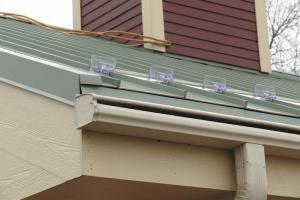2008 - Volume #32, Issue #3, Page #17
[ Sample Stories From This Issue | List of All Stories In This Issue | Print this story
| Read this issue]
No Well Needed At This Rural Home
 |
 |
 |
 |
"Wells in this area are going down 600 feet and getting water with high levels of nitrate," says Milaster, who lives in a part of southeastern Minnesota where sinkholes are prevalent.
The answer makes even more sense if you consider that his home is also off the electric grid. His small wind turbine generates enough power for the house, but not enough for a 240-volt pump for a well. A low power pump to fill a cistern would have required its own solar panel. To go on grid with his location would have cost him another $12,000.
To design his water storage system, Milaster calculated daily needs and then added capacity for an eventual family. He determined his 2,500 sq. ft. roof would supply him with 1,500 gal. of water from each 1-in. rain.
The only constraint would be having enough storage to carry him through winter. A friend who relies on a cistern for house water suggested having enough storage for 100 days.
Milaster decided to go with 7,500 gal. of storage. He acknowledges that his system is overbuilt for a one-person household. While he only uses around 40 gal./day, he hopes to eventually have a family, so he installed three 2,500 gal. tanks in his basement. A fourth smaller tank installed outside stores over-run for potential yard and garden use.
"I started this past December with a full system, and it never dropped below 4,800 gallons," he says. "We had a little rain in January and some snow melt bringing it back up to 6,600 gal. by late March."
Milaster credits little things like the snow rakes he installed on his steel roof. They catch and hold snow until it can melt, rather than slide off the roof. He also has water efficient appliances and even bought special toilets developed in Australia. They give him a choice of flushing with either 0.8 or 1.6 gal. of water.
"I also have a backup system with a pipe inlet in my garage so I could have a tank truck bring in water in the case of an extended dry period," says Milaster.
Debris has been kept to a minimum in the system, thanks to leaf guard gutters. He still plans to install a first flush diversion system that would divert initial rainfall until the roof had been flushed clean. However, he notes that his 300-gal. settling tank has not collected any material to date. Water flows from the settling tank into the three main storage tanks, which are connected in line, maintaining equal levels at all times.
Milaster's only regret with his system is not installing an in-ground cistern away from the house. High humidity in his water tank room has resulted in mold on the walls and ceiling that he is working to contain, if not eliminate.
"Once I have my full solar power system in place, I hope to get the humidity down in the room," he says.
Milaster plans to install a photovoltaic panel to add capacity to his current system. At this time, he still relies on a backup generator when wind power is insufficient.
The only change ahead for the water system is a plan to install a reverse osmosis filtration system for drinking water. Currently he fills jugs with filtered water at nearby supermarkets.
"I haven't tested water quality yet, as a complete analysis would cost $120," he explains. "As a single person, I only spend about $80 a year to bring in drinking water."
Milaster maintains a web page with extensive information about his off-well, off-grid home.
Contact: FARM SHOW Followup, Christian Milaster, 100 Hidden Valley Drive, Lanesboro, Minn. 55949 (ph 507 467-3088; www.lichtnstein.org, christian@lichtnstein. org).

Click here to download page story appeared in.

Click here to read entire issue
To read the rest of this story, download this issue below or click here to register with your account number.




